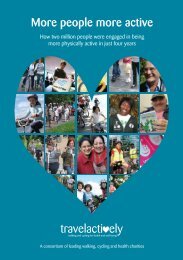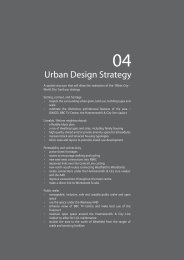Travel in London Travel in London
travel-in-london-report-8
travel-in-london-report-8
You also want an ePaper? Increase the reach of your titles
YUMPU automatically turns print PDFs into web optimized ePapers that Google loves.
9. <strong>London</strong>’s air quality and greenhouse gas emissions and transport and public health<br />
9. <strong>London</strong>’s air quality and greenhouse gas emissions<br />
and transport and public health<br />
9.1 Background and content<br />
This chapter looks at the related topics of local air quality and climate change<br />
emissions from ground-based transport <strong>in</strong> <strong>London</strong>. The transport sector is an<br />
important primary contributor of local air quality and greenhouse gas emissions, and<br />
is also an important secondary determ<strong>in</strong>ant through, for example, it’s <strong>in</strong>fluence on<br />
urban geography and the need to travel. The MTS therefore sets out a broad<br />
framework for reduc<strong>in</strong>g these emissions from ground-based transport. These are<br />
elaborated <strong>in</strong> a wider context via the Mayor’s Air Quality Strategy<br />
(see http://www.cleanerairforlondon.org.uk/policy/mayors-air-quality-strategy) and<br />
his Climate Change Mitigation and Energy Strategy<br />
(see: https://www.london.gov.uk/sites/default/files/gla_migrate_files_dest<strong>in</strong>ation/C<br />
CMES%20annual%20report_2013-14_0.pdf). The first part of this chapter gives a<br />
broad review of progress <strong>in</strong> tackl<strong>in</strong>g these emissions over the term of the current<br />
MTS to date.<br />
Dur<strong>in</strong>g 2015 TfL has revised and updated <strong>London</strong>’s emissions <strong>in</strong>ventories –<br />
comprehensive datasets that identify and quantify emissions to air from transport<br />
and all other pollut<strong>in</strong>g activities. TfL has yet to fully validate these new data and<br />
evaluate their full significance for air quality and greenhouse gas policy <strong>in</strong> <strong>London</strong>.<br />
Full results from the <strong>in</strong>ventory updates will be published dur<strong>in</strong>g 2016 and the<br />
datasets made available for general use by air quality practitioners. Some <strong>in</strong>itial<br />
f<strong>in</strong>d<strong>in</strong>gs – relat<strong>in</strong>g specifically to changes <strong>in</strong> <strong>London</strong>’s emissions from ground-based<br />
transport between 2008 and 2013 – are however published <strong>in</strong> this chapter on a<br />
provisional basis.<br />
9.2 Local air quality and greenhouse gas emissions – recent <strong>in</strong>itiatives<br />
Why pollution matters<br />
Air pollutants can have a detrimental effect on the health of people and<br />
ecosystems, and are l<strong>in</strong>ked to climate change. The most common pollutants of<br />
concern <strong>in</strong> <strong>London</strong> are particulates, particularly those f<strong>in</strong>e particles under<br />
10microns <strong>in</strong> size (PM 10 and PM 2.5 ), NO x and NO 2 , and CO 2 . It is generally accepted<br />
that particles have a zero threshold, <strong>in</strong> that any levels can potentially be dangerous<br />
to human health, but standards have been set at the EU level (known as limit<br />
values) which sets a recommended level at which pollution levels should be below<br />
<strong>in</strong> order to protect the population from wider health effects.<br />
F<strong>in</strong>e particles can penetrate deeply <strong>in</strong>to the lungs and enter the blood stream;<br />
chronic exposure to particles contributes the long term risks of develop<strong>in</strong>g<br />
cardiovascular and respiratory diseases. Health impacts of NO 2 are less understood<br />
but it now accepted that longer term exposure to high levels of NO 2 can affect lung<br />
growth and function <strong>in</strong> children, particularly those with underly<strong>in</strong>g health conditions<br />
such as asthma. NOx/NO2 is an important precursor <strong>in</strong> the formation of particles<br />
and ozone.<br />
TFL/GLA recently commissioned K<strong>in</strong>g’s College to quantify the health impacts of<br />
PM 10 / 2.5 and NO 2 . For the first time, the health burden of these pollutants was<br />
estimated at around 9,400 equivalent deaths brought forward <strong>in</strong> 2010. The study<br />
163 <strong>Travel</strong> <strong>in</strong> <strong>London</strong>, Report 8








